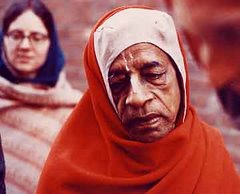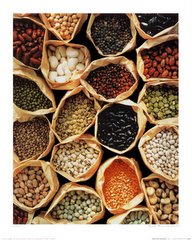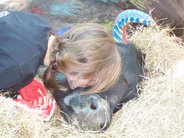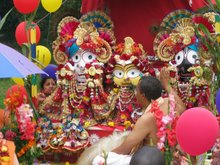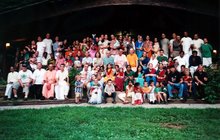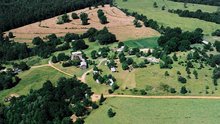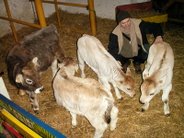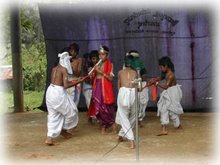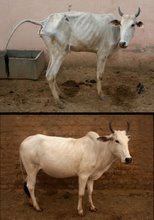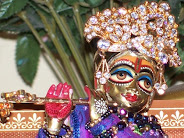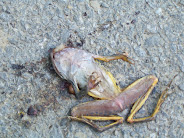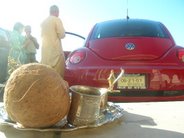
Sunday, October 21, 2007
We're moving...

Monday, October 15, 2007
Feed the World Week
 A Call for Action!
A Call for Action! October 15-21 will mark the annual observance of Feed the World Week (FWW). During this week, Food for Life volunteers and concerned vegetarians in over 60 countries will serve out more than 5 million karma-free vegetarian meals to the world!
Objectives
- Feed the World Week is based on a simple principle: For one week, the world should experience a wholesome, nonviolent diet, and thus pave the way for a peaceful and prosperous world.
- Feed the World Week is an open community event to show how food when prepared and distributed with love, has the power to unite and heal the world.
- Feed the World Week is a call for action: for the world to move away from animal agriculture—the greatest cause of environmental destruction and the principle reason why there is so much hunger in the world today. Most non-vegetarians are unaware that more than 70% of the world’s grain production is fed to livestock destined for slaughterhouses. That same grain could feed humans. Every year, millions of children in the developing world die from hunger, alongside fields of fodder destined for the West’s livestock.
In an attempt to correct this imbalance of the earth’s resources, Food for Life volunteers daily distribute over 800,000 karma-free meals to the needy of the world!
During Feed the World Week, we share vegetarian food in remembrance of the world’s 1.3 billion hungry. The fact is, if Americans reduced their meat consumption by 10 percent, enough grains would be saved to feed sixty million people!
For more info, check out the Food For Life website.Saturday, October 13, 2007
COWS RISE UP!
 Bovines Across the Nation Unite in Call for Access to Organic Pasture, Eradication of Synthetic Hormones and a Better Day for Bovine Sisters
Bovines Across the Nation Unite in Call for Access to Organic Pasture, Eradication of Synthetic Hormones and a Better Day for Bovine SistersOPEN PASTURES ACROSS THE NATION (June 04, 2007)—Cows Have the Right to Be Cows. Cows Have the Right to Graze. Cows Have the Right to Clean Air. Cows Have the Right to Dignity and Joy.
These are just a few of the rights cows nationwide are presenting as part of their agreed-upon "Bovine Bill of Rights"—a historic document found at http://www.cowsunite.org/ that is the centerpiece of "Cows Unite," a movement unveiling afoot in which a strong affiliation of cows in pastures coast-to-coast have created to help humans understand the importance of organic dairy, decent treatment for cows and the critical role of family farmers.
Cows Unite has already received support from a number of leaders in the sustainable food movement, including Organic Valley, Beyond Pesticides, Bioneers, Farm Aid, and Ecotrust. "We are most pleased with the support that our movement has received, since going public," said the spokescow. "Our sponsors provide powerful links to the humans needed to make our dream a reality."
"Stay tuned for more information," said the spokescow for Cows Unite, who wished not to have her identity disclosed. "It is time for action. It is time for organization. It is time to finally air our beefs about the way our bovine sisters are treated, about the air we breathe, the grass we eat, and the milk we produce.
"The resistance, my Sisters, begins now."
- Cows have the right to be cows.Cows are not machines—we are equals in the interdependent circle of life. All our rights begin with this right.
- Cows have the right to graze.Turn us loose to graze in pastures free of synthetic pesticides and herbicides. We will take only what we need and we will refresh the soil. You will be happier for it, too. Our milk will be delicious and delightful. Promise.
- Cows have the right to just say no to drugs.The days of experimentation are over. Stop pushing the synthetic hormones and antibiotics! Organic is the right way for Sisters everywhere.
- Cows have the right to dignity and joy.When we are free to move about outdoors, it’s our best opportunity for dignity, health and joy—and a chance at joy should be the right of all living things. Even dogs.
- Cows have the right to decent help.Sure, us cows are the all-stars, but the time has come to say thanks to the little guys – the family farmers. We can’t do this alone. Fair pay for an honest day’s nurturing and care. It’s all we ask. Viva la Family Farm!
- Cows have the right to clean air.Nothing makes us breath easier than local customers. When you choose milk from pastures close by, you reduce trucking. It’s pretty nifty. Less air pollution, less fuel used, and support for your neighboring Farmers, all from one little milk choice.
Sign up to receive your first assignment with coupons.
Tell your friends about www.cowsunite.org.
Thank you, Sister! Dunk in peace.
Wednesday, October 10, 2007

TRANSLATION
by Srila Prabhupada
During the reign of Maharaja Yudhisthira, the clouds showered all the water that people needed, and the earth produced all the necessities of man in profusion. Due to its fatty milk bag and cheerful attitude, the cow used to moisten the grazing ground with milk.
PURPORT
The basic principle of economic development is centered on land and cows. The necessities of human society are food grains, fruits, milk, minerals, clothing, wood, etc. One requires all these items to fulfill the material needs of the body. Certainly one does not require flesh and fish or iron tools and machinery. During the regime of Maharaja Yudhisthira all over the world there were regulated rainfalls. Rainfalls are not in the control of the human being. The heavenly King Indradeva is the controller of rains, and he is the servant of the Lord. When the Lord is obeyed by the king and the people under the king's administration, there are regulated rains from the horizon, and these rains are the causes of all varieties of production on the land. Not only do regulated rains help ample production of grains and fruits, but when they combine with astronomical influences there is ample production of valuable stones and pearls. Grains and vegetables can sumptuously feed a man and animals, and a fatty cow delivers enough milk to supply a man sumptuously with vigor and vitality. If there is enough milk, enough grains, enough fruit, enough cotton, enough silk and enough jewels, then why do the people need cinemas, houses of prostitution, slaughterhouses, etc.? What is the need of an artificial luxurious life of cinema, cars, radio, flesh and hotels? Has this civilization produced anything but quarreling individually and nationally? Has this civilization enhanced the cause of equality and fraternity by sending thousands of men into a hellish factory and the war fields at the whims of a particular man?
It is said here that the cows used to moisten the pasturing land with milk because their milk bags were fatty and the animals were joyful. Do they not require, therefore, proper protection for a joyful life by being fed with a sufficient quantity of grass in the field? Why should men kill cows for their selfish purposes? Why should man not be satisfied with grains, fruits and milk, which, combined together, can produce hundreds and thousands of palatable dishes. Why are there slaughterhouses all over the world to kill innocent animals? Maharaja Pariksit grandson of Maharaja Yudhisthira while touring his vast kingdom, saw a black man attempting to kill a cow. The King at once arrested the butcher and chastised him sufficiently. Should not a king or executive head protect the lives of the poor animals who are unable to defend themselves? Is this humanity? Are not the animals of a country citizens also? Then why are they allowed to be butchered in organized slaughterhouses? Are these the signs of equality, fraternity and nonviolence?
Therefore, in contrast with the modern, advanced, civilized form of government, an autocracy like Maharaja Yudhisthira's is by far superior to a so-called democracy in which animals are killed and a man less than an animal is allowed to cast votes for another less-than-animal man.
We are all creatures of material nature. In the Bhagavad-gita is said that the Lord Himself is the seed-giving father and material nature is the mother of all living beings in all shapes. Thus mother material nature has enough foodstuff both for animals and for men, by the grace of the Father Almighty, Sri Krsna. The human being is the elder brother of all other living beings. He is endowed with intelligence more powerful than animals for realizing the course of nature and the indications of the Almighty Father. Human civilizations should depend on the production of material nature without artificially attempting economic development to turn the world into a chaos of artificial greed and power only for the purpose of artificial luxuries and sense gratification. This is but the life of dogs and hogs.
Sunday, October 7, 2007
Physician's Commitee for Responsible Medicine
 Ever wonder why cheeseburgers are so cheap? Or why school cafeterias still serve more meatloaf and hot dogs than fruits and vegetables? The answer may surprise you.
Ever wonder why cheeseburgers are so cheap? Or why school cafeterias still serve more meatloaf and hot dogs than fruits and vegetables? The answer may surprise you.The Farm Bill, America's primary federal food
policy, keeps high-fat, cholesterol-laden pork,
beef, cheese, and other unhealthy animal
products cheap and widely available. That's
why I hope you'll take action today to help
spread the word about the Physician's
Committee for Responsible Medicine (PCRM)'s
new hard-hitting Farm Bill commercial.
The Farm Bill doled out more than $70 billion in
food subsidy payments from 1995 to 2005,
and more than three-quarters of that money
went to producers of meat, sugar, oil, dairy,
alcohol, and feed crops used in meat production.
Fruit and vegetable farmers received less than
1 percent of government subsidies. To make
matters worse, the federal government
purchases Farm Bill surplus foods like cheese, milk, pork, and beef for distribution to food assistance
programs--including the National School Lunch Program.
As you may know, the House of representatives made only minor changes to the subsidy
system when it passed its version of the bill in July. Now that the Senate Agriculture
Committee is expected to begin marking up its version of the Farm Bill in October, PCRM
and other groups are calling for sweeping changes. PCRM has been calling attention to the
problem with a new television ad about the Farm Bill, which directs people to
StopChildhoodObesityNow.org. Our ad has been covered by The Wall Street Journal, The
Huffington Post, MSNBC.com, and many other media outlets. As the bill comes before
the Senate over the next month, I'll need your help to send a strong message about
reform. See how PCRM and other groups are calling sweeping changes.
Here's how you can help:
1. Watch PCRM's new Farm Bill ad on YouTube.
2. Support PCRM's efforts to reform the Farm Bill by making a donation now.
Donations from you and other concerned citizens will help PCRM air the Farm Bill ad
in even more media markets across the country and support our other activities to
make the Farm Bill healthier.
3. Forward this e-mail and let others know why they should care about the Farm Bill, too.
4. Call and e-mail your senators. Urge them to make healthy changes to the Farm Bill.
I'll be contacting you again in the next few weeks with more updates on the Farm
Bill and more details about how you can help as the bill moves through the Senate.
Thank you so much for your support and help in reforming the Farm Bill. As always,
please feel free to contact me if you have any questions.
Best regards,
Kyle Ash
Legislative Coordinator
kash@pcrm.org
Wednesday, October 3, 2007
BASIL- Bhaktivedanta Academy for Sustainable Integrated Living


BASIL is the academic wing of ISKCON Bangalore’s rural development programme, Eco-Agri Research Foundation (EARF). BASIL aims to present facts about the imminent danger to health and life that has been caused by consumption of poison in the name of food, it may demand safe food production,
that will make society healthy and disease free.
In order to facilitate these goals, BASIL is conducting training courses in Organic and Biodynamic farming Systems. This training will benefit Farmers, Corporate Sectors as well as laymen with knowledge of safe food and health choices. This Programme will also help the people to understand Holistic lifestyle and Simple living.
Forthcoming Training Programs:
Training programmes on 'organic and bio-dynamic farming systems'
Date : 4th to 9th October 2007(6 days) and October 31st to 3rd November 2007 (4 days)
Venue: at its facility on the outskirts of Mysore at Mahadevapura village.
The training programme is open to progressive farmers, agriculture professionals, students of plant world, ecology and eco-conscious consumers.
Participation certificate will be issued. Since there are only limited seats available for the training program, interested participants are requested to register at the earliest.
For registration and fee details contact,
Eco-Agri Research Foundation
Tele Fax: +91-821-2491016,
e-mail: info@basilacademy.in
Sunday, September 30, 2007
Srimad Bhagavatam, Translation by Srila Prabhupada

nadyah samudrā girayah
savanaspati-vīrudhah
phalanty osadhayah sarvāh
kāmam anvrtu tasya vai
SYNONYMS
nadyah — rivers; samudrāh — oceans; girayah — hills and mountains; savanaspati — vegetables; vīrudhah — creepers; phalanti — active; osadhayah — drugs; sarvāh— all; kāmam — necessities; anvrtu — seasonal; tasya — for the King; vai— certainly.
The rivers, oceans, hills, mountains, forests, creepers and active drugs, in every season, paid their tax quota to the King in profusion.
PURPORT
Since Maharaja Yudhisthira was under the protection of the ajita, the infallible Lord, as above mentioned, the properties of the Lord, namely the rivers, oceans, hills, forests, etc., were all pleased, and they used to supply their respective quota of taxes to the King. The secret to success is to take refuge under the protection of the Supreme Lord. Without His sanction, nothing can be possible. To make economic development by our own endeavors on the strength of tools and machinery is not all. The sanction of the Supreme Lord must be there, otherwise despite all instrumental arrangements everything will be unsuccessful. The ultimate cause of success is the daiva, the Supreme. Kings like Mahārāja Yudhisthira knew perfectly well that the king is the agent of the Supreme Lord to look after the welfare of the mass of people. Actually the state belongs to the Supreme Lord. The rivers, oceans, forests, hills, drugs, etc., are not creations of man. They are all creations of the Supreme Lord, and the living being is allowed to make use of the property of the Lord for the service of the Lord. Today's slogan is that everything is for the people, and therefore the government is for the people and by the people. But to produce a new species of humanity at the present moment on the basis of God consciousness and perfection of human life, the ideology of godly communism, the world has to again follow in the footsteps of kings like Mahārāja Yudhisthira or Parīksit. There is enough of everything by the will of the Lord, and we can make proper use of things to live comfortably without enmity between men, or animal and man or nature. The control of the Lord is everywhere, and if the Lord is pleased, every part of nature will be pleased. The river will flow profusely to fertilize the land; the oceans will supply sufficient quantities of minerals, pearls and jewels; the forest will supply sufficient wood, drugs and vegetables, and the seasonal changes will effectively help produce fruits and flowers in profuse quantity. The artificial way of living depending on factories and tools can render so-called happiness only to a limited number at the cost of millions. Since the energy of the mass of people is engaged in factory production, the natural products are being hampered, and for this the mass is unhappy. Without being educated properly, the mass of people are following in the footsteps of the vested interests by exploiting natural reserves, and therefore there is acute competition between individual and individual and nation and nation. There is no control by the trained agent of the Lord. We must look into the defects of modern civilization by comparison here, and should follow in the footsteps of Mahārāja Yudhisthira to cleanse man and wipe out anachronisms.
Thursday, September 27, 2007
Excerpts from Vedic Ecology by Ranchor Prime

-Srila Prabhupada (excerpt from commentary on Srimad Bhagavatam 1.10.4)
Friday, September 21, 2007
How to Save the World
 How to Save the World is a revolutionary film, documenting the rebirth of the bio-dynamic movement in the motherland of India.
How to Save the World is a revolutionary film, documenting the rebirth of the bio-dynamic movement in the motherland of India.The film exposes agricultural globalization as an environmental and human disaster. But Indian marginalized farmers are fighting back by reviving bio-dynamic techniques into their traditional agricultural practices. While saving their poisoned lands, bio- dynamics is becoming a major force in reclaiming peasant agriculture in India from the multinational, agricultural giants who's only objective is profit with no concern for the welfare of the people, land, or cows.
To see the trailer of this film, click here.
For more information about the Bio-Dynamic Association of India, click here.
"For the dissident audience, the mission of this environmental
documentary is to corrode the mantra of development equals progress, jobs, and a
strong economy. For an apathetic audience, the mission is to open a wedge in the
indifference. For younger audiences, the mission is to educate and recruit a new
generation to activism. For sympathetic audiences, the mission is to inspire and
energize the troops. " -The Last Stand by Emily D. Edwards, PhD
Monday, September 17, 2007
Environmentalism According to the Vedic View
 By Stephen Knapp
By Stephen KnappThe environment means nature, and whose nature is it? It is God’s nature. Did anyone else create it? Did anyone else put it all together so that it operates the way it does? In fact, mankind is still trying to figure out all the intricacies of its functionality.
In all the inventions or devices we produce, all the ingredients and resources that we use are all given by God. The elements we need to make big buildings, bridges, ships, cars, or the fuel to operate them, are all being given by God, and we need to show the proper respect. To think we are the proprietors of everything is the illusion. It is our pride that makes us think we are so intelligent when actually the very brain with which we think is not created by us but has again been given by God.
As everything is created from the Supreme Creator, then we should certainly have a high regard for everything as the expansion of God’s energies. This not only includes all of our fellow men, but all creatures, as well as all aspects of the planet. Violence toward the planet in the form of not caring for the environment, misusing and polluting our natural resources, not managing the land and forests properly, are all forms of disrespect toward God and the blessings that have been given us. Why should we expect God to continue giving us the necessities of life, or the means to acquire them, if we are going to ruin them, or do not know how to care for them properly? So we must never pollute our resources or waste the food we have.
We should also see that even the Earth is a living being, full of life. The globe is a mother to us since she supplies all that we need. All of our food, water, and resources for sustaining our own lives, as well as supplies for shelter and clothing, all come from her. How she reciprocates with us in regard to what she provides depends on how we treat, honor and care for her. The imbalance in nature, such as the green house effect, the changing climate and weather patterns, are reflections of the imbalance in the consciousness of humanity. Once there is balance and harmony in society’s consciousness and the way we regard and treat the ecosystem, this will then be reflected in the balance in nature. Then many of the storms, natural upheavals and disasters will begin to cease.
The environment and the material creation are supplied with all the potencies to produce all the necessities that we require, not only for humans but also for all species. Human society should not consider itself as the only enjoyer of all of God’s creation, and that no other creatures have a claim to it. Humanity is actually a minority species when we consider the many types of creatures that are sustained by the environment. If we manage the ecosystem properly, it will continue to produce everything we need. However, if people who have no genuine spiritual understanding start exploiting the Earth to take whatever they want in any way they want, then the supply of resources starts decreasing and the Earth, being a living organism, stops producing or responding to the needs of society as abundantly as it used to do. Then there will be shortages, droughts, and forest fires; subsequently the prices on commodities will increase. Gradually more people will become poor, and poverty and starvation will spread in parts of the world. Then we see fierce competition for whatever resources can be attained. When many people die while fighting over land and commodities, or temporary and ever-changing political stances, then all the bloodshed from the dead, dying or wounded is like offering Mother Earth blood sacrifices to drink. She is pained by this, as are so many other higher beings that watch the activities of humanity. Rather than respecting the Earth and cooperating to share her resources, when we fight over them it is most heartrending for Mother Earth. Thus, when the Earth and the Lord’s environment are not properly appreciated and maintained, or are exploited by ungodly people, then scarcities and excess pollution is the result. However, nature itself can go on nicely except for the interference of ungodly men.
As a society controlled by godless men gathers all the resources from the land as fast as possible for power and quick profits, it may appear to be a mighty economic gain at first, but in time it is never enough. As demand grows, scarcity raises its angry head. When the environment is not respected and cared for properly, there are also changes in the various species that have existed for thousands of years, even extinctions. These are all signs of further unknown changes in the future that will be revealing themselves to us when it will be too late.
There may be times when the Earth needs to cleanse herself of unwanted activities or from the pain she suffers from society’s wrong aims of life. She may move in various ways to adjust things so that humanity is not so out of balance and will be forced to reconfigure the value systems that are displayed by humanity and make them geared more toward the real goal of life. When Earth reacts in particular ways to relieve her from the weight of unwanted activities or segments of society, we should not miss the message. A society that is too spoiled often easily forgets the real reason why it is here.
The proper vision is that everything is the property of the Supreme Being. If we have any possessions or wealth, we should see that we are only borrowing them for a short time. We certainly cannot take them with us when we leave this body, thus someone else will take it all when we are gone. The ultimate owner of everything is the Supreme Creator. Thus, the proper way to use anything is in the service or consciousness of God. The same goes for taking care of the environment. Everything belongs to God so, ultimately, we should take care of it as if we were being watched by God and only taking care of His property while, by God’s good graces, it produces the resources we need to live. After all, as the Lord in our heart and as the Supersoul of every living being, He is observing everything we do.
All of one’s land, home, wealth, and possessions belong to the Supreme Being though we wrongly think, AI am this body and all that belongs to it is mine@. Thus, a person of wisdom should not see anything as separate from the Supreme Lord. In spiritual consciousness, such a person will see everything, whether it be fire, air, water, the earth, the sun and stars, all living beings, the trees and plants, the rivers and oceans, and in fact everything that exists as an expansion of the energies of the Supreme Lord. Even while actively engaged with so many objects and undertakings in this creation, a person who sees the whole world as the energy of the Supreme Being is indeed a great sage of wisdom.
Therefore, we should care for the environment as if it is not ours but God’s property, and in this way assure ourselves that it will continue to provide all of our necessities for many years to come, and into many future generations. This is the Vedic view.
Thursday, September 13, 2007
Was milk drawn in a different way in Srila Prabhupada's time?
Based on the assumption that we should continue drinking milk, apart from
our own farms with hand milked cows what are the better alternatives. Even
organic farms use milking machines.
There is a major crisis within our society as you know very well. Srila
Prabhupada has asked ISKCON to produce their own food as well as other
things. This is certainly not prioritised within the management structures
and resources are not generally directed to developing more self
sufficiency. At the same time are own production of milk taking into account
the entire herd is protected and the oxen are used to care for the farm and
grow all the food needed milk will be at least 6 times more expensive than
is available in the market place (at least that is the case in the west).
As far as I know milk in India is 15 Rupees a litre and with a minimum daily
salary of 100 rupees that means a litre of milk is one sixth the cost of
days wages. In the uk with a minimum daily wage of £38 (7 working hours)
that would make a litre of milk at £6 equivelent. Would our devotees pay
this figure.
So we have to be sure what we are asking of our devotees. Protected milk is
not available in the market, at the same time devotees seem unwilling to pay
the real price from the goshallas. At the same time we must drink milk. So
in identifying what is wrong with milk we should not be pushing our devotees
into veganism as Srila Prabhupada could have asked us to do that but did
not.
From what I can see at the moment there is no push to provide milk for all
our farms even, what to speak of the other centres and projects and what to
speak of the devotee congregation.
If we dont get it together then somebody in another organisation or
buisiness will do it and we will be left feeling somebody has stolen our
fruit.
The solution is for ISKCON to provide its own milk and products and that way
we dont have to source them commercially. This is not easy. Until we make
cow protection livelihood based it will not take off but it will continue to
decline as it has been steadily over the last decades. We are witnessing the
demise of more and more farm projects if something drastic is not done soon
then it will be a great disaster.
Tuesday, September 11, 2007
Veganism and Krishna Consciousness
Srila Prabhupada has written, "Real philosophy is nothing more than this: friendliness to all living entities." Elsewhere, he writes, "If people are to be educated in the path back to Godhead, they must be taught first and foremost to stop the process of animal-killing."
I became vegan for a few years beginning in 1995. I was pointing out to friends at a Feminists For Life meeting that for 1800 years, Christians had upheld and defended (human) slavery on biblical grounds, and that history was now repeating itself with regards to animals.
The response I got from the women present was that my words would carry greater weight if I were vegan rather than vegetarian, and I had to admit they were right. There is a great deal of cruelty in the way dairy products are obtained through modern factory farming.
To ignore this kind of suffering merely because we believe dairy products are somehow "necessary" for our spiritual advancement (they are not) is to trivialize the former and it will allow people of other faiths to counter that we are vegetarian merely because we follow "dietary laws" rather than out of genuine concern for animals.
Lord Caitanya made vegetarianism central to the sankirtana movement when He brought up the subject of meat-eating with the Chand Kazi of Navadvipa. And Srila Prabhupada followed our Lord's example by repeatedly bringing up the subject with people of other faiths ("thou shalt not kill").
In a purport from the First Canto of the Srimad Bhagavatam, Srila Prabhupada writes: "It is nonsensical to say that the killing of animals has nothing to do with spiritual realization."
Similarly, in his purport to the Srimad Bhagavatam 6.10.9, Srila Prabhupada writes:
"One cannot continue killing animals and at the same time be a religious man. That is the greatest hypocrisy. Jesus Christ said, 'Do not kill,' but hypocrites nevertheless maintain thousands of slaughterhouses while posing as Christians. Such hypocrisy is condemned..."
Srila Prabhupada even candidly told a Catholic priest in London in 1973, that, "Animal-killers cannot understand God. I have seen this. It is a fact."
Srila Prabhupada said, "...as far as meat-eating is concerned, every cow will die—so you just wait awhile, and there will be so many dead cows. Then you can take all the dead cows and eat...Don't kill. When the cow is dead, you can eat it."
Entry continued here.
Saturday, September 1, 2007
Amish Fight Against Microchip Regulations
"He also forced everyone, small and great, rich and poor, free and slave, toBLANCHARD -- Glen Mast doesn't own a computer, doesn't want one, but he and other Amish farmers complain the state Department of Agriculture is insisting they tag their cattle with electronic chips in violation oftheir religious beliefs.
receive a mark on his right hand or on his forehead, so that no one could buy or
sell unless he had the mark, which is the name of the beast or the number of his
name."-- Holy Bible New International Version, Revelation 13:16-17
State agriculture officials say the radio frequency chips are necessaryto track animal diseases and protect public health. Mast and other Amish farmers say the chips' 15-digit number is the Mark of the Beast warned of in the Bible's book of Revelation.
"We're a people who are inclined to mind our own business," Mast said, sitting in the wood shop he operates without electricity on his Isabella County farm. His small herd of dairy cows lounged in the shade of the barn. Across the road, one of his sons raked hay with a team of horses. "We're never happier than when we're just left alone," Mast said. "That's all we're asking."
All over Michigan, Amish farmers are resisting the state program requiring that all cattle be tagged with the electronic chips before they can be sold. Some say they will quit farming if it comes to it. Some say they will leave the state.
"They keep saying that, and that's their choice," said Kevin Kirk, who coordinates the program for the state agriculture department. "Our No. 1 goal is animal health, human health and food safety. I know it's hard sometimes to trust the government, but that's what we're asking is trust us."
State exceeds national program Michigan's program, which began March 1, is part of a National Animal Identification System created after the outbreaks of mad cow disease and foot-and-mouth disease in Europe and hastened by fears of terrorist attacks on the United States' food supply. The national program, administered by the U.S. Department ofAgriculture, is voluntary.
Michigan is one of the few state's making itmandatory because of a 1998 tuberculosis outbreak among cattle in the northeast Lower Peninsula. Under the program, each farm is issued a seven-digit identification number entered in a national database. All cattle must have theelectronic ear tags, which cost $2 each, before they can be moved offthe farm. Scanners at livestock auctions and slaughter houses automatically read the ear tags, tracking each animal's movements.
While the program covers only cattle, it might be expanded to all farm animals, Kirk said. Most Michigan cattle already are marked with metalear tags embossed with numbers, allowing health officials to track them, but Kirk said the computerized system is much faster.
"If we have a disease outbreak, we don't have months to track it," he said. Amish farmers, he said, produced a "very, very small" percentage of then early 397 million pounds of beef sold by Michigan farmers last year.
Not all Amish raise cattle, but those who do typically have herds of eight or 10 animals. But the Amish aren't the only farmers opposing the new system. Several organizations representing small farmers are fighting it nationally, claiming it is costly, bureaucratic and intrusive.
Gale Faling, who is not Amish but raises beef cattle in the midst of a Montcalm County Amish community, said the old system was working fine. "I don't see the need to change it," he said. "To me, it's another layer of government interference."
A neighbor, Amish farmer Alvin Shetler, agreed. "We're not against the government," he said. "We're thankful for the freedom we got, and we'd like to continue with that."
So far, the state has not forced the Amish to use the electronic tagsbut, as a compromise, said they can wait until the animals arrive at an auction before having them applied. The Amish, that makes nodifference.
Stating their opposition
In April, Mast, Shetler and a few dozen other Amish farmers appearedbefore the state Senate Appropriations Committee, urging it to block the program, a decidedly unAmish act, since they do not vote, run for office or receive any government money.
Craig Starkweather, chief of staff for Sen. Alan Cropsey, R-DeWitt, said his boss may introduce a bill granting a religious exemption if the agriculture department tries forcing the Amish to comply. Mast cited Revelation, which says the beast forced everyone "to receive a mark on his right hand or on his forehead, so that no one could buy or sell unless he had the mark."
"They're asking me to use this number to be allowed to buy and sell," he said. "To me, the beast is the computer." Mast said he will not file a lawsuit to block the program. "We feel that Jesus has taught us to turn the other cheek rather than sue," he said. "If they persecute you in one place, just flee, go the other way. Probably, we'd just leave."
Thursday, August 23, 2007
Leadership in Energy and Environmental Design
What is LEED®?
The Leadership in Energy and Environmental Design (LEED) Green Building Rating System™ is the nationally accepted benchmark for the design, construction, and operation of high performance green buildings. LEED gives building owners and operators the tools they need to have an immediate and measurable impact on their buildings’ performance. LEED promotes a whole-building approach to sustainability by recognizing performance in five key areas of human and environmental health: sustainable site development, water savings, energy efficiency, materials selection, and indoor environmental quality.
LEED provides a roadmap for measuring and documenting success for every building type and phase of a building lifecycle. Specific LEED programs include:
New Commercial Construction and Major Renovation projects
Existing Building Operations and Maintenance
Commercial Interiors projects
Core and Shell Development projects
Homes
Neighborhood Development
Guidelines for Multiple Buildings and On-Campus Building Projects
LEED for Schools
LEED for Retail
USGBC is also developing LEED for Healthcare, and LEED for Labs.
We also have the LEED Resources page which has informative PowerPoint presentations, brochures, and case studies, as well as LEED News and LEED-Online sample credit templates.
How is LEED Developed?
The LEED Rating System was created to transform the built environment to sustainability by providing the building industry with consistent, credible standards for what constitutes a green building. The rating system is developed and continuously refined via an open, consensus-based process that has made LEED the green building standard of choice for Federal agencies and state and local governments nationwide. Click here for more information on the LEED Development Process.
What is LEED Certification?
The first step to LEED certification is to Register your project. A project is a viable candidate for LEED certification if it can meet all prerequisites and achieve the minimum number of points to earn the Certified level of LEED project certification. To earn certification, a building project must meet certain prerequisites and performance benchmarks ("credits") within each category. Projects are awarded Certified, Silver, Gold, or Platinum certification depending on the number of credits they achieve. This comprehensive approach is the reason LEED-certified buildings have reduced operating costs, healthier and more productive occupants, and conserve our natural resources.
Note for Product Manufacturers and Service Providers:
Although USGBC does not certify, promote, or endorse products and services of individual companies, products and services do play a role and can help projects with credit achievement. (Note that products and services do not earn projects points.) Learn more here about how you and your company can help advance green building, while also achieving your own environmental and economic goals.
Who Can Use LEED?
Everyone: Architects, real estate professionals, facility managers, engineers, interior designers, landscape architects, construction managers, lenders, government officials...
The LEED program also includes a full suite of training workshops and a Professional Accreditation program to develop and encourage green building expertise across the entire building industry.
Questions?
Visit the LEED Help section of our website.
Wednesday, August 22, 2007
Organic Farming Could Feed the World
Along with reporting on fertilizers, biotech, ethanol, corporate consolidation and the agrofuels vs food debate comes an increased science reporting of the real world of organic-ecological-diversified agriculture that actually feeds the world.
The biotech industry used to regard speed as one of the defining characteristics of genetic engineering. To prove the point, it rushed new products to market with little regard for the consequences. Speed, however, is a characteristic of neither good science nor sustain-able agriculture. Now the 'slow' reports of scientific findings on nutritious food and sustainable agriculture are beginning to surface. It will be interesting to see how the biotech bullies deal with these. The authors of a new study* claim that a switch to organic farming would not reduce the world's food supply but could actually increase food security in developing countries. They claim their findings lay to rest the debate over whether organic farming could sustainably feed the world. The team of researchers has compiled research from 293 different comparisons into a single study to assess the overall efficiency of the two agricultural systems.
They found that in 'developed' countries organic systems produce, on average, 92% of the yield produced by conventional agriculture. In 'developing' countries, however, organic systems produce 80% more than conventional farms. Then, using data from the UN Food and Agriculture Organization, the team estimated what would happen if farms world-wide were to switch to organic methods today.
The researchers found that under an organic-only regime, farms could produce between 2641 and 4381 calories per person per day compared to the current world equivalent of 2786 calories per person per day. Members of the team believe the calculations they carried out to arrive at the upper number are the most realistic. These took into account the higher yields that would be obtained in developing countries, and the details of which crops are grown where. Nutritionists recommend that people consume between 2100 and 2500 calories a day.
The researchers found that small farms tend to produce more per hectare of land. They also note that although organic production tends to require more labour, this labour is often spread out more evenly over the growing season, making it easier to manage. They also point out that once you incorporate the environmental costs, then organic agriculture is a much superior system.
In this era of climate change and unpredicted disasters (droughts, floods, heat waves, etc.) organic/ecological agriculture has another important virtue. Relying on locally-sourced and adapted species and varieties as well as labour, knowledge, and skills, it is much more resilient than a system which is dependent on manufactured and imported inputs.The issue of speed is also crucial. As George Monbiot has persuasively argued, air travel may be the single most intractable cause of carbon emissions. But fast boats, trains, and cars are also problematic. The fact is that when you take the whole system into account, speed is simply not efficient. Slower modes of transport would, of course, limit the perishable food and other products which are now shipped around the globe, and make us all more dependent on what we can produce ourselves. Not a bad idea.
* Organic agriculture and the global food supply: Catherine Badgley, Jeremy Moghtader, Eileen Quintero, Emily Zakem, M. Jahi Chappell, Katia Avilés-Vázquez, Andrea Samulon and Ivette Perfecto, Renewable Agriculture and Food Systems, 2007, Cambridge University Press
Tuesday, August 21, 2007
Is local the new organic?
Last week, The New York Times ran a feature by Marian Burros on New Seasons Markets, a grocery store chain in Portland that's banking on consumer interest in local, sustainable food -- as opposed to simply organic.
The chain recently completed an inventory of the origins of its stock and has labeled everything grown in Oregon, Washington, and Northern California "Homegrown." They've already got six stores and three more on the way, but remain adamantly opposed to expanding beyond the Portland suburbs -- a testament to their commitment to being grounded in the local food economy.
People concerned about health, taste, and the environment have long sought out organic products. Once a cutting-edge concept for gourmets and health-food junkies, organic is now mainstream, with many familiar major food brands launching organic product lines. I bought organic milk at a Seattle Safeway the other day that was packaged under Safeway's own new "O" label. Organics are the fastest growing segment of the food industry, with sales increasing by some 20 percent per year.
But, as the NYT piece notes, organic alone is not the answer to the question of the fundamental role food plays in our local economy, environment, food security, community vitality, or even health and enjoyment. I don't know where that organic milk I bought from Safeway came from. I like the idea of sticking with my delivery from Smith Brothers dairy each week. Even though it's not organic, there's no growth hormone used and I am supporting the last of the independent dairy farms in my state, Washington.
We won't be seeing New Seasons outside the Portland area any time soon -- but other areas are making progress on the local food front.
In the Seattle area, for example, cutting-edge projects are exploring food as a driver in the local economy and as a focal point for public policies ranging from health and nutrition to urban planning and even transportation.
Sustainable Seattle is launching a first-of-its-kind research project looking at how dollars spent on locally produced food affect the local economy, as a counterpoint to the dollar spent on the average grocery item that has traveled 1500 miles to reach the consumer.
Washington State University's King County Extension office is leading an effort to establish a food policy council for Seattle and King County that would bring together a broad spectrum of food system participants -- from farmers to hunger activists to grocery executives to land use experts -- to work jointly on solutions to current challenges like childhood obesity, disappearing farmland, and alarmingly high levels of hunger in our community.
I have always believed in the power of coming to the table together to hash out issues, find common ground, and be reminded of one another's humanity, but I have most often thought about it in the very personal context of family and friends. In these times of bitter division, can coming to the table in celebration of delicious local-grown bounty help remind us of our many shared values and experiences?
Saturday, August 18, 2007
Does Krishna Like Milk From Unprotected Cows?
I just read this article on Dandavats and it encouraged me to hurry up and write an article that I’ve been wanting to write for a long time. Most of the information in this article is from Peta, the vegan society, and http://www.milksucks.com/ (I know, not a nice name, but they have some good info).
One of the first things I heard when I met the devotees was “you can’t be a vegan devotee.” This is because Krishna loves milk and milk products and devotees love to offer them to him.
The problem is that the milk we (in the cities) are offering to Krishna is not pure. As Jahnava mataji said last Saturday, actually all foods in Kali Yuga are considered to be impure.
Krishna doesn’t just love milk, Krishna loves cows. So how does he feel if we are offering him grocery store milk that is laden with antibiotics and growth hormones—milk that comes from cows that are abused and mistreated and finally sent to the slaughterhouse?
To give milk the cow must be pregnant and then have a calf. On both organic and non-organic farms, cows are kept continuously pregnant. On non-organic farms mother cows are treated like machines, chained by their necks in concrete stalls for months at a time, their udders are swollen so large that they sometimes drag on the ground. Cows give milk for the same reasons humans do—to feed their babies. To keep milk production high, cows are kept pregnant by artificial insemination and their male calves are taken away at 1-2 days old and chained inside cramped dark crates to be killed for veal. The milk meant for them is what we buy on the grocery shelves. They are not even given a chance to drink their mother’s milk.
It is too easy to turn a blind eye to what goes on behind the grocery store shelves. After all, how can we not offer milk sweets to Krishna? How will the Sunday feast go on without sweet rice?
But how can we offer milk sweets to Krishna using milk that (unless organic) contains hormones, antibiotics, disease, blood, fish and who knows what else? Cows are so dear to Lord Krishna that I just cannot imagine he would want to taste milk from cows so horribly abused, or even if not abused (organic cows), nevertheless sent to the slaughterhouse.
The ideal is, as Sivarama Swami says, to support the Iskcon farms in their efforts to protect the cows and offer pure milk to Krishna. But for those of us who live far from farms and must buy milk from the store, it seems that abstaining from milk products is the only choice. A vegan diet is the only option for cow protection living in the city.
Find the full article at http://namahatta.org/nh2/en/node/5535
Friday, August 10, 2007
Thoughts on Shambo the Bull and Other Sacred Animals.

Article from The Vaishnava Voice
It seems like everyone wants to read about Shambo the bull. My blog visitor numbers have never been so high. Even at the London Rathayatra festival on Sunday, people were asking us: “Is this a protest march for Shambo?”
The story of Shambo the bull is of course a sad tale. Despite last minute sea changes in the legal decisions, and despite much public sympathy, 20,000 signatures and a hundred sitting in protest at the temple in Wales, Shambo was ultimately taken away to be killed.
His plight, and the plight of those trying to save his life, was not really sympathised with by certain journalists. Reading the situation as being one of sentimental monks fretting about their pet bull, they castigated them for not seeing the relative importance of a ‘pet animal’ when compared to the health of other cows or indeed of humans who might catch TB.
Other writers, catching the fundamentalist fatigue in the British public, noted that here was another case where one groups eccentric religious laws were meant to be pandered to at the expense of us all. Other farmers have had their herds culled due to TB infection, and many other farmers lost their entire herd to foot and mouth disease within recent years. They were also troubled by their loss but ultimately had to do the decent thing and surrender them for slaughter. Why so much fuss about one “sacred” bull?
They’re missing the point. Shambo was sacred not because he was a bull living in a temple. And he was not sacred because some Hindu monks had designated him as such. And he was not sacred because he was a Hindu bull. As bulls go, Shambo was no more or less sacred than any other bull happily grazing in any field.
All bulls, cows, and indeed all life, is worthy of our reverence and protection. The world’s oldest scripture calls upon us to see a spark of the Divine in all beings, and especially in those animals which have been designated by God to provide for our existence in some way. Through them, we come to see our connection to the Divine and how we are cared for. The Skanda Vale temple just happened to be one of the few places in the country where this approach to the sanctity of life was honoured and practised. And Shambo - for a few brief years - just happened to be on the receiving end of such vision and generosity.
Perhaps we have all participated in bringing about the natural catastrophes that now threaten farmers everywhere. Incessant demand for meat and increased milk yield have turned our four-legged mothers and fathers into walking bags of hormones and antibiotics. Who knows what natural bovine immunities become extinct after generations of this treatment?
Ultimately the Vedas explain that ahimsa or non-violence is the path that human beings are meant to tread if they wish to make progress on the upward path. The repercussions of this choice will restore nobility to our increasingly violent society and safeguard us all. And non-violence begins with our tongue; not hurting others with our words, and not hurting others with our choice of food.
This was written a few centuries ago by Thiruvalluvar, an Indian poet, in his book Thirukural or Sacred Couplets :
How can he practice true compassion
who eats the flesh of an animal to fatten his own flesh?
Riches cannot be found in the hands of the thriftless,
nor can compassion be found in the hearts of those who eat meat.
He who feasts on a creature’s flesh is like he who wields a weapon. Goodness is never one with the minds of these two.
If you ask, “What is kindness and what is unkindness?”
It is not-killing and killing. Thus, eating flesh is never virtuous.
Life is perpetuated by not eating meat.
The jaws of Hell close on those who do.
If the world did not purchase and consume meat,
no one would slaughter and offer meat for sale.
When a man realizes that meat is the butchered flesh
of another creature, he will abstain from eating it.
Insightful souls who have abandoned the passion to hurt others will not feed on flesh that life has abandoned.
Greater than a thousand ghee offerings consumed in sacrificial fires is to not sacrifice and consume any living creature.
All life will press palms together in prayerful adoration
of those who refuse to slaughter or savour meat.
Sunday, August 5, 2007
What Are You Doing for Cow Protection?

By HH Sivarama Swami
Krsi goraksya vanijya. Krsi means ploughing or agriculture and goraksya, cow protection. These are the staples of society, this is what people live on. All living entities subsist on grains. So the ksatriyas may direct and instruct people, the brahmanas may perform their yajnas, but if they don’t eat then giving shelter or instruction is not going to work.
That eating is therefore the most essential aspect of life and this is why the vaisyas and their assistants, the sudras, are so integral that the other castes think that they are the most important people, because it is actually they who are feeding. Of course the vaisyas think that the brahmanas are the most important because they are taking the result of their work and offering it back to the Lord.
Srila Prabhupada said that this very common type of exchange was there but the responsibility of this goraksya, is it the duty of just some people? Some very very exclusive people? Is it the responsibility of all vaisyas, or is it for all grhastas or all devotees?
My proposition is that it is everyone’s responsibility. Just like everyone’s responsibility is chanting Hare Krishna, watering Tulasi devi, reading Bhagavatam. Similarly part of our common dharma is to protect cows. This is something that you see ingrained in communities like Bhaktivedanta Manor, where they have to limit the amount of cows they receive as gifts, and be very careful about the type of food that is offered to the cows, because to a greater or lesser degree all the devotees see the protection of cows as their dharma.
It is everyone’s dharma: the cow is our mother, she gives us milk while all over the rest of the world cows are being butchered, slaughtered, abused, and taken advantage of. Vaisnavas must take it as their responsibility to protect cows. Now, how do you protect cows? Does that mean that you have a cow on your balcony in downtown Singapore? No, that type of cow protection is actually cow abuse. You cannot just keep your own cow.
Cows only give milk if they have calves, which means you have to constantly have calves, which means you have to have a herd, and that is a full time business. So how is it that individuals should protect cows? They should in some way or another be connected to ISKCON’s herds. Srila Prabhupada established cow protection for instance in New Vrindavan, Gita Nagari, or as we have done here in Hungary at New Vraja-dhama. These herds are not the sole responsibility or duty of the local devotees in those places, they are the responsibility of the devotees and congregation of the local country. It is their responsibility to contribute to the cow protection, to donate towards the maintenance of the cow, to come and do some cow seva, and when they come to the temple they should bring some bhoga for the cows, to find out what items are needed by the cowherds. And the cow herds.
Cow protection is everyone’s business, it is everyone’s responsibility. This is being written down as varnasrama dharma. If one does not contribute or participate directly in cow protection then he should know that he is neglecting his dharma, he is neglecting his dharma. In other words he is adharmic.
This is in my view the greater picture of what varnasrama means. Varnasrama doesn’t mean that we simply philosophise about a way of life, but what are the duties of varnas and asramas, what are the duties that are common for all Vaisnavas, for all humans. And one of them is the protection of cows, just like chanting Hare Krsna is a common responsibility as mentioned earlier.
So, similairly, cow protection is a common responsibility for everyone. It doesn’t necessarily always occur to us, and even when it does, it’s difficult to get devotees interested. More difficult than getting devotees to do sankirtan, more difficult than getting someone to cook in the kitchen or be temple president, is to get devotees to be cowherds. To make devotees work with the cows, bulls, and oxen and to make that their life, it is very difficult for devotees to do this. “I am an educated person, I have this diploma and you want me to take care of cows? You want me to do that thing that God does? You want me to do that activity that is going on in the spiritual world?”
And that is what is going on the spiritual world. That is what is going on where we are going–at least where I want to go is where there is only gopas and gopis. The whole social identity is based on go, on cows. There are milkmaids and there are cowherd men. And if we are not willing to be milkmaids and cowherd men here in the material world, if this service is beyond us and we cannot forsee how we are going to dedicate our lives to working with the cows, then were are we going? Then you had better look for somewhere other than Braja. Then you had better go to Dwaraka or Vaikuntha, where that is not a compulsory, integral part of life.
Because in the spiritual world, in Goloka Vrindavan, Krishna goes out every day to tend cows. And yet it is so difficult to get devotees to be cowherders, to see that this is a respectable future, and to stick with that service. Because once again, cow protection is something that we talk about as being against the principles of slaughtering the animals. We don’t believe in slaughtering the cow, we don’t believe in eating the meat of the cow, cows should be properly protected. But, when it comes to properly protecting the cows, are we willing to do it? Are we actually willing to dedicate our lives to taking care of cows? Or are we willing to participate and support the protection of cows?
Therefore, we should ask: “What am I doing for protecting my mother? What am I doing to sustain cow protection in my zone? It is my responsibility, my duty as a Vaisnava. Am I performing my dharmic duty?”
Sunday, July 22, 2007
Ox Power
 Excerpt from the Working Villages International website
Excerpt from the Working Villages International websiteThe twentieth century has produced three basic models of economic development: 1. Export (raw materials or manufactured goods); 2. Tourism; 3. Import substitution, using imported equipment. All three models depend to a greater or lesser degree on access to cheap petroleum.
The price of gasoline in Congo is now $8-$10 per gallon, and the average yearly income in Congo is $99 - enough to buy at most 12 gallons of gasoline per year. So the question arises: How can traditional, petroleum-dependent models of economic development benefit the people under such circumstances? What are the alternatives? Working Villages believes that much hope is to be found in the models advocated by Gandhi and E.F Schumacher (author of Small is Beautiful), which explain the benefits of village self-reliance in the form of localized economics and wide-spread small scale ownership, relying on local resources and skills.
Saturday, July 21, 2007
Drive to remove stray animals in Agra, India hits roadblock
The much-hyped and long-awaited campaign to remove stray animals from urban
areas in Agra has been stalled by complaints from animal activist Maneka
Gandhi.
In a series of complaints to the Uttar Pradesh chief secretary, Agra
divisional commissioner and other officials, Gandhi has accused Agra
Municipal Commissioner Shyam Singh Yadav of ordering 'the mass killing of
dogs', a charge vehemently denied by Yadav.Gandhi has also accused the
municipal commissioner of 'planning to kill all monkeys, donkeys and cows to
make Agra completely animal-free'.
'The experiment to relocate monkeys had not succeeded anywhere in India. In
Vrindavan they had tried this experiment and all the monkeys perished. Delhi
also tried to relocate the monkeys in the Bhatti mines; more than 600 died.
'If the authorities in Agra want to kill them let them say so. Before
transporting the monkeys, a proper survey of the area and the forest should
be done to make sure they had enough to eat there and the facilities
available could sustain them,' Gandhi told IANS.
Ravindra Choudhary, head of the Animal Husbandry Department of the Agra
Municipal Corporation, said: 'People are being bitten by monkeys daily.
Unfortunately, there are no medical facilities available for treatment and
no anti-rabbies vaccines. And how can the poor afford treatment?'
According to Choudhary, there are more than 10,000 monkeys in Agra but an
animal welfare NGO estimates that there are close to 50,000 monkeys and they
seem to be multiplying at a fast rate.
In 1996, the Supreme Court had ordered that dairies should be shifted
outside the city and several directives were subsequently issued on the same
order. The Uttar Pradesh government had also issued a gazette notification
in 2002 to control animal population and capture stray animals.
Yadav said that the registration of all pet animals has now been made
mandatory. 'I am also looking for a suitable design to prevent littering on
the roads by horses deployed to haul carriages. The excreta of horses would
be collected in a leather bag and then disposed of,' he added.
Although Maneka's initiative has for the moment halted all projects to rid
the city of stray animals, Mukesh Jain, the private financer of the 'Catch
the Monkeys' campaign, said that he would go ahead with the drive in the
last week of July.
'We are following the rule book and there is nothing illegal about it. The
charge of killing the animals is baseless. The animal lovers are free to
feed the monkeys in the jungle. But why allow the monkeys to bite human
beings?' he asked.
In her letter to the Agra divisional commissioner, Gandhi said, 'Street dogs
and cattle forage in the garbage, cleaning it of all organic waste. In their
absence uncollected garbage will rot and smell.
'India has a long tradition of peaceful coexistence with animals. What makes
our cities special is that we share them freely with animals. To remove
animals from a city leaving only the sterility of cars and buildings in a
foolish aping of the west is to destroy the city's character and soul.
'The Agra-Vrindavan-Mathura area holds a special sentiment for all Indians
as the place of the cowherd god Krishna. Would we rid his place of cows or
any other creatures?'
Locals want all stray animals, including dogs and cattle rounded up, and the
monkeys killed or transported to some other location.
'Due to the fear of monkeys we have not had the courage to sleep on our
terraces in this hot weather. Women can't go to the roof tops and spend some
time there in the cold winter months as these monkeys target children and
young women,' said Bankey Lal, a shopkeeper.
'It's not a happy situation to be in,' said Mukesh Jain. He has already
spent quite a lot of money on catching monkeys and is willing to finance the
drive till the last monkey has been dispatched to the forest.
The municipal corporation wants a drastic reduction in the number of
animals. Gandhi has suggested sterilisation of dogs by her organisation
People for Animals (PFA) as she thinks this would be a more humane approach
to the problem.
Vasudha Mehta of the NGO Wildlife SOS, which runs a rescue centre for sloth
bears in Agra, suggests a rescue centre for monkeys. 'Let's work on some
netted enclosure with electric fencing on the river bank. Put all the
monkeys there and feed them at one point.
'Obviously, it is a very tricky problem, all the more because of people's
religious sentiments. So we must work on some innovative ideas and
technologies in the interest of the human race,' she said.
Thursday, June 21, 2007
Divine Nature
 by Michael A. Cremo & Mukunda Goswami
by Michael A. Cremo & Mukunda GoswamiWhat are the root causes of the environmental crisis? What can we do about them?
"Does a highly spiritual tradition like Krishna consciousness concern itself with concrete problems of this world? Do the teachings have a significant environmental impact?
"Divine Nature is a clear, even eloquent ‘yes' answer to both questions. The chapter on ‘Meat and the Environment' is the best succinct statement I have read on the environmental impact of meat consumption. But Divine Nature deftly weaves this concrete factual material into a worldview which includes history, scientific theory, and the metaphysics of karma. The implications of diet are far-reaching. Divine Nature is a must for professors of religion like myself and for students like mine. It shows us that the apparently abstract and ethereal realm of spirituality bears upon the environment in a quite positive and practical way."
From the back cover:
According to Divine Nature, the real cause of the global environmental crisis is an underlying lack of spiritual understanding. The authors systematically demonstrate that most proposed solutions are only palliative and that humankind must undergo a profound change in consciousness to live in an environmentally sound way.
"Divine Nature leads the human spirit upward. The authors lucidly explore the dimensions of a genuine solution to the world's environmental crisis. They suggest that the most important changes must come first within each of us—in the way we see ourselves and the universe, the way we eat, and the way we live." George Harrison, singer, UK
"A book of hope and transformation, conviction, and dedication, and I urge all who care to read and share." Dr. Michael Fox, Vice PresidentThe Humane Society of the United States
"In view of the crying need for excellent literature concerning the interface of spirituality and the environment, Divine Nature is a Godsend." Gene Sager, Professor of Religious Studies and PhilosophyPalomar College, California
"Divine Nature reminds us we must learn again to live within the laws of nature …aware and grateful that we are at the mercy of sacred forces larger than ourselves." From the Foreword by William McDonougharchitect, author of The Hannover Principles.
Thursday, June 14, 2007
Modern Technology- no fuel, no electricity, & pollution free

Friday, June 1, 2007
From Rooftop to Restaurant - A University Cafe Fed by a Rooftop Garden
Co-written by Aimee Blyth and Leslie Menagh, Urban Agriculture Notes
Visible from either side of the Otonabee River, a mere five-minute stroll across the Trent University campus bridge, a rooftop garden and little café are working toward social and environmental change, specifically a shift in food culture.
For about a decade now, Professor Tom Hutchinson, a local farmer and ecologist, has been supervising an intensive vegetable garden on the roof of the Environmental Sciences building at Trent University. The reasons for the garden are many. Historically, it has provided a site for monitoring the effects of air pollution and smog on agricultural crops. More recently, it has served as learning space for students in the Food and Agriculture Emphasis Program at the school. And in Toms' own words, "it demonstrates our ability to use unused space for productive purposes. Since most people live in cities it behooves us to maximize the ecological aspects of the urban environment. Rooftop gardens clean up pollution and create esthetically pleasing, calming places to be."

Today, the garden grows organic food for local groups interested in food security and sustainable agriculture. Among these is The Seasoned Spoon Café. "The Spoon" as the restaurant is affectionately called, has a mandate to source its ingredients locally thereby reducing the energy it takes to transport healthy food to consumers. It is the only restaurant of its kind at the university as it is a student-run, independent co-operative that stands as a politically driven alternative to Aramark. The American food catering giant which predominantly provides food on campus contracts other corporations such as Tim Hortons and Pizza Pizza. So, like Tom's rooftop, The Spoon also provides unique opportunities for practical learning, from studies in small business operation to bioregionalism.
While most students are away for the summer, the rooftop and the restaurant have hired us: a gardener and a summer cook. With a shared love for all things gastronomic and growing, staff, volunteers, and Spoon customers are increasingly aware of the varied components of local food culture, and their interdependence. Spoon cooks can often be found weeding, sifting compost, or harvesting food, in turn deepening their appreciation for seasonality.
Whereas fast food may have been an attractive novelty some decades ago, we have seen a significant shift in the desires of eaters at the university and beyond, toward food that is ethically produced. It tastes better because the flavours are as fresh and varied as local farmers' produce. Furthermore, the price is as easy to swallow as any other food served at the school, and is often less costly. In fact, what we're seeing is that taste is determined by much more than what generically-produced, hyper-packaged products could ever offer - the ingredients of which have travelled farther than any human is likely to travel in their lifetime, chocked full of unpronounceable preservatives that enable it to do so. People like to feel good about what they're eating. It feels - and therefore tastes - better "to know that the means of production are ecologically and socially sound", says TimWilson, customer and member of The Spoon. And at the rooftop garden, we are committed to doing just that.
The Gardener's Story"What is it?", Scott, my fellow rooftop gardener asked.
I wasn't sure. I'd never seen this striking, green-black striped caterpillar before. We decided to leave it where we found it on the plant, and I went home to look it up; parsleyworm is its name. It eats the foliage of members of the umbelliferae family, including the parsley plant where we'd seen it. Like so many other gardeners, we were charmed by the beauty of this bug. One of my gardening textbooks - a rather dry book that I had thought contained no adjectives - describes the parsleyworm as "stunning". This little caterpillar, seems to have escaped the scorn that other garden pests command, such as the cabbageworm (which I, like most other gardeners, pick off whenever I see one). This distinction may not be without justification, however, as the parsleyworm, in the end, did little damage to our parsley crop. The trade-off was the later arrival of a another butterfly to the garden - a black swallowtail.

Working in the treetops among the butterflies, birds, bees and squirrels we cultivate vegetables, herbs, and edible flowers, including many heirloom varieties. Having never taken care of a rooftop garden before, I was surprised by the ways it differs from a traditional garden. The main differences can be summed up in two words: sun and wind. The resulting growing conditions tend to be more extreme. Even after a good rain, it takes very little time for the beds to dry out; our solution is mulch, mulch and more mulch. Even so, not everything grows well on the roof. In particular, we have difficulty with spinach, peas and beans. Other heat-loving plants, however, do very well including tomatoes, peppers and basil.
Another significant limitation on the roof is soil fertility. In the spring we recruit unsuspecting (or very generous) volunteers to help us haul compost from The Spoon. We further amend the soil with sheep manure from Tom's farm, green manure and compost tea. In particular using green manures or compost tea is labour-saving, because it precludes the need to bring more materials up to the roof through the Environmental Sciences Boardroom (the only access to the roof).
Despite these challenges, rooftop gardening provides a number of incentives. We need not worry about pests such as deer. Furthermore, what is a challenge in the summer - namely the warmer, dryer conditions - is an advantage in the spring when we're able to start gardening a few weeks earlier than the surrounding area. Thus the rooftop climate acts as a season extension.
Fortunately for us, the rooftop garden was a part of the initial building design. Thus, not only is there proper irrigation and drainage, but the building has sufficient load-bearing capabilities to support eighteen inches of saturated soil. To prevent water and roots from compromising the roof there is an impermeable membrane beneath the soil. The garden acts as a temperature moderator for the building below, cooling it down in the summer and insulating it in the winter.
On a larger scale rooftop gardens and sod roofs can do the same in a city. A recent study prepared by Ryerson University for the City of Toronto, found that green roofs significantly reduce stormwater runoff, reduce energy consumption and the reduce the heat island effect. Furthermore, they help to beautify the city and create more natural green spaces in urban areas - for everyone, including the black swallowtails.
Article continued at: http://www.cityfarmer.org/TrentRoof.html